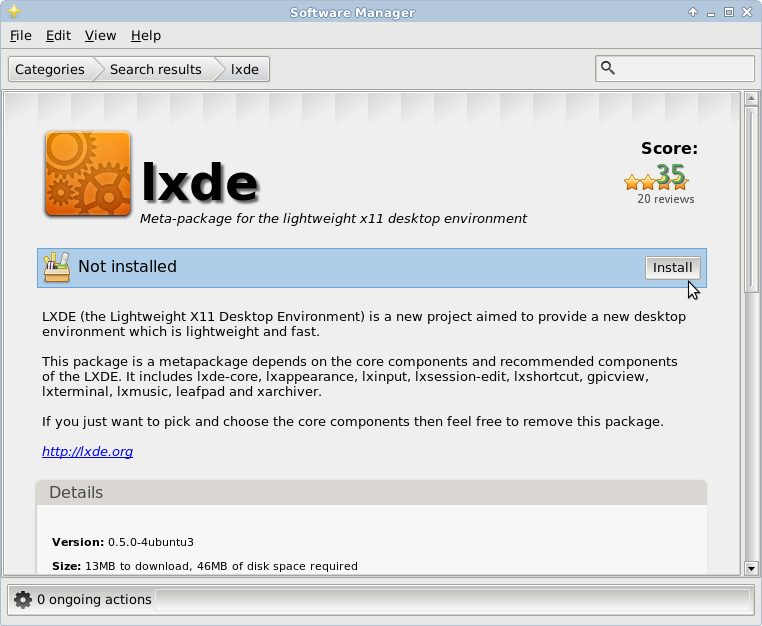How to Instal and Manage Multiple Desktop Environments Using GUI
|
13 years ago 9 |
Installing a Desktop Environment {D/E) is not the same as installing an Operating System. A D/E is simply a manager for your OS which in our case is Linux Mint. All of your data files remain unaffected and so do a lot of your applications (although not all of your applications as some are specific to certain D/Es). Have a look at Robin's post in "What is the difference between Debian, Fluxbox, XFCE, ..." in the Linux Mint forums for more detailed information.
All D/Es allow you to run Firefox, Opera, Thunderbird, LibreOffice and all the usual applications that users want. It is in the area of the bells and whistles that you will find major differences ("Why won't Xfce do [put favourite theme/panel applet here]?" and such}.
Installing an additional Desktp Environment adds a complete version of that D/E and will provide the full user experience within your existing Linux Mint Operating System. However, adding extra D/Es alongside the one you originally insatalled does not provide the equivalent Linux Mint experience for the added D/E (e.g. the 'Linux Mint' wallpaper won't appear). Of course, your originally installed Linux Mint will remain unchanged. If you decide you prefer another D/E over the one you originally installed and you want to achieve the full Linux Mint experience, you will need to do a complete fresh instal of the Linix Mint version of that D/E (if there is one).
1. Preparation
- If you don't want to take my word for it, then just back up your data files to an external HDD or somesuch. It's not necessary but you might feel more comfortable if you do.
- Be aware that the file structures for the various D/Es vary in size considerably. For example KDE requires some 850MB of disk space whereas Fluxbox only needs 6MB. You need to ensure your system will accommodate the extra files.
- Also, some D/Es can be quite demanding on your system's resources. Because of the infinite variety of hardware combinations it is impossible to deal with that subject here but you will also need to ensure that your proposed new D/E is within the capabilities of your hardware. (Another good reason to backup your data and applications if you're not sure.)
2. Instal the Desktop Environment
For this example we'll use LXDE as the D/E that you wish to install alongside your existing D/E. The same procedure will work for other D/E's and Window Managers (KDE, Cinnamon, Xfce, Fluxbox, etc.)
- Navigate to 'Software Manager'. In most D/E's this can be found in the 'Menu' under 'System' or 'Administration'.

- Type "lxde" in the search box and double-click 'lxde' in the results shown (it'll probably be the first listing}

- Click on the 'Install' button.

- When installation is 100% complete close the Software Manager (even if the manager says application is still "Not installed" as it's prone to do in some environments)
3. Change Your Session
- Close all windows and 'Log Out' of your existing session. (IMPORTANT - choose the 'Log Out' button or select the 'Log Out' option from the 'Shutdown' window)
- Either, if you have a recent Linux Mint version with the Mint Display Manager 'Wecome'/'Log In' window, click the 'Session' button that shows under the Username box in the Welcome screen.

- Or, if you have an older version with a panel bar at the bottom of the 'Log In' screen, select which user you want to login as. Then a small box will appear on the bottom panel bar and you click on that.
- Change the session to LXDE

- Log in as you usually would
Congratulations! You are now running in the LXDE Desktop Environment. It will look a bit or a lot different to your existing D/E (it's just as customisable though) but a bit of quick investigation will show that you still have all your files. Not all your applications will be shown because some applications will be incompatible with LXDE but, as in all D/E's, there are LXDE applications that will do what most users want.
If you decide you don't like your new D/E you can log out and change your session back to your previous one. You can then either leave the LXDE files on your computer for future investigation (recommended as you'll probably want another look at some future point) or you can remove the files by doing another LXDE search in the Software Manager and then click the 'Remove' button that will have replaced the 'Install' button for that application.

Comments
Great infor thart is hard to find
i tried this way for last several day, i got some error, where appliaction in lxde run in gnome when i switch to gnome
Good tutorial, but I agree that a rather large warning about possible side-effects should be included.
Overall a good tutorial.
Thanks to remoulder for pointing out the risks involved in installing and/or using aftermarket DE's.
Whilst this sounds like and is an easy thing to do, users should be aware that using different DEs on the same system with the same home can lead to strange problems and errors. Installing another DE can change system files and dependencies, alter default system and application settings, and create incompatibilities. A browse through the forums will show the kind of strange issues that can arise, this is why there are different editions of Mint rather than a single one (size issues aside).